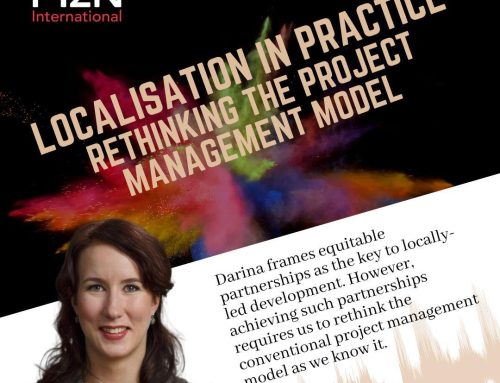Commercial contracts are buzzwords in today’s non-profit world. Everyone is talking about their potential to fund programmes and most seem to agree that they are a useful addition to the ideal funding mix. However, hardly anyone knows where to start.
The topic is even asked with trepidation, since the world of commercial contracting is sometimes perceived of as challenging the very nature of non-profit organisations themselves.
What’s a commercial contract?
Commercial contracts do not fund programmes, instead they buy programmatic services. They are based on the premise that donors are paying for a predefined service, rather than funding a set of project activities. Payments are often made on a Payment-by-Result (PbR) basis, that is, in arrears upon the successful completion of a service or activity.
That said, commercial contracts are increasingly part of how our clients look to deliver impact. However, partly because of their newness, they are often the part of the funding mix with the least well formulated plan. Most non-profits are traditionally built for grant-attracting and grant-implementing work as well as the attracting and spending of donations. Commercial contracts, on the other hand, are value-driven, service contracts, often paid on results, in arrears – something many agencies find institutionally difficult to handle.
So, how does an organisation best move beyond traditional grant or donor funding towards a healthy future -proofed funding mix that includes commercial contracts? To shed a little light on the subject, here are the answers to our most frequently asked questions:
1. Is it worth it?
Let’s only do it if it is worth it! After all, the competition is stiff, and the risks can be high. However, commercial contracts are an important and expanding, funding line that would be too risky to ignore.
In uncertain political and economic times, where aid fatigue and less international solidarity with the less fortunate are on the rise, PbR contracts are often seen by donors as the answer. Voters and taxpayers who are subjected to the politics of austerity themselves view PbR contracts as efficient ways of assisting the poor. The rationale is that the tax-payer will only pay for what is actually achieved, supposedly eliminating ineffective aid or misspent funds we have all heard so much about.
The likelihood is that, in the future, more donor funding will be channelled through commercial PbR contracts. In 2017, 14 per cent of DFID’s spending was through commercial contracts and this percentage is set to grow over the coming years
[1]. The EU has committed to using more PbR contracts, along with an increasing number of institutional donors in Germany, France, Denmark, Norway and Italy
[2]. In a world where there are no longer certainties in donor or public funding streams, commercial contracting is too big an opportunity to miss out on.
2. How do we manage the funding process?
So how do we do it? First of all, it is key to realise that commercial funding is a mind shift from traditional funding: Commercial contracts do not fund programmes, instead they buy programmatic services. Many non-profits are used to grant management, their organisational DNA; their systems and their processes are all geared towards this mode of delivery.
Grants are predominantly prefunded and are focused and guided by compliance with the terms of reference. Commercial contracting is different, contracts are driven by the best value offer to fulfil the pre-defined scope of work and are paid upon completion. This has far ranging consequences for the management of commercial contracts. There are differences in the way contracts are negotiated, there are different pricing and costing mechanisms as well as very different reporting mechanisms.
The good news is that many organisations already possesses many of the skills and processes necessary to work in commercial contracting, they just need to be realigned.
3. What skills do we need for successful commercial contracting?
Many of the skills and processes required are the same. Organisations with significant grant funded experience will have many of the skills to bid for and operate commercial contracts. There is likely to be a need to change the focus of the skills and processes as well as refocus mind sets to meet the requirements of the commercial aspects of the contracts.
As we have explained, the major differences come in the way the contracts are priced and paid. The financial aspects of commercial contracting whilst appearing more complex and riskier than grants, aren’t really. The skills needed for organisations to successfully budget and deliver large grant funded projects are ultimately the same, just new perspectives on income flows are merely required.
4. Are commercial contracts riskier?
Financially there are risks to both grant funded and commercially contracted work. Commercial work carries a pre-financing risk since the work is done before the payment is made. This risk is exacerbated by the fact that all operational costs need to be built into the service delivery. Grant funded work, however, is no less risky; any payments made can be reclaimed by the donor if the work is not compliant. If organisations can manage the financial risks of grant funded work, with a little focus they can manage the risks of commercial contracts.
5. How to prepare for commercial contracts?
It’s important to realise that commercial contracts might add significant funding but are not the silver bullet to all funding related prayers. They must form part of a sensible funding mix that has a reasonable likelihood of being able to fund all activities necessary to realise the organisation’s theory of change. The good news is that the way commercial contracts are structured means that organisations are able to generate a surplus over and above the cost of delivering the service. This surplus can be invested in doing more good, in funding programmatic innovation or be invested in deficit-generating grant-funded work that fulfils the organisations mandate.
To successfully integrate commercial contracts into an organisation’s toolbox of funding lines, non-profit leaders need to determine the exact role that commercial contracts should play in the organisation’s programmatic future. Once determined, the organisation needs to plan and invest in the necessary systems and mindset changes that can make commercial contracting successful and viable for the organisation’s future.





